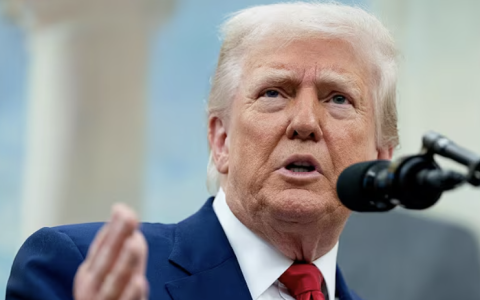Trump called it a "nasty question"—but what does the "TACO" trade mean for your wallet?
By
Veronica E.
- Replies 0
If you’ve been watching financial news lately, you might have heard about something called the “TACO” trade
It’s a new acronym being used by some investors and analysts to describe how the markets react to tariff announcements from President Donald Trump.
It’s not about lunch—it stands for “Trump Always Changes Outcome” or, more informally in some circles, “Trump Always Chickens Out.”
While the name may raise eyebrows, the core idea reflects a serious market trend: initial stock declines when major tariffs are announced, followed by rebounds when those tariffs are delayed or adjusted.
Whether you support the strategy or view it with skepticism, this emerging pattern is shaping how some investors respond to US trade policy.

How the TACO theory started
The term was first coined on May 2 by Financial Times journalist Robert Armstrong, who described how the markets tend to dip when aggressive tariffs are proposed, but often recover once the administration eases off or postpones them.
Armstrong wrote, “The recent rally has a lot to do with markets realizing that the US administration does not have a very high tolerance for market and economic pressure, and will be quick to back off when tariffs cause pain. This is the TACO theory: Trump Always Chickens Out.”
Since then, a few examples have helped the term catch on:
Also read: Retailers scramble to keep prices steady amid tariff pressure: Are shoppers the ones who pay?
Trump’s response: "It’s called negotiation"
When asked about the theory at a White House event, Trump pushed back, calling the phrase a “nasty question.”
He emphasized that his use of tariffs is part of a deliberate negotiation strategy, stating: “They wouldn’t be over here today negotiating if I didn’t put a 50% tariff on Europe.”
He added, “[T]hey'll say, oh, he was chicken. He was chicken. That's unbelievable. I usually have the opposite problem. They say, 'You're too tough, Mr. President.'”
Also read: Tariff plan paused—Trump steps back after market chaos shakes investors
What this means for investors
Market analysts have taken note of this pattern.
In a research note dated May 28, Adam Crisafulli of Vital Knowledge observed that "[T]he narrative is growing increasingly bullish as investors become more comfortable with the severity of the tariff threat (the "TACO" mindset is being embraced by more people) while companies demonstrate an ability to absorb the import tax hike relatively well (the hit to [earnings per share] hasn't been as draconian as feared),"
In short, some investors believe that even if tariffs are proposed, they may not be long-lasting.
This has created a sense of cautious optimism on Wall Street.
But some say caution is still warranted
Still, not everyone is convinced the markets should feel so relaxed.
Major retailers like Walmart have warned that tariffs—if enacted—could lead to higher prices for consumers.
And Moody’s recently raised concerns about the US government’s rising debt, pointing to long-term fiscal risks.
Crisafulli notes that while the outlook may remain calm for now, things could shift quickly if delayed tariffs are reactivated or if inflation from trade policies starts showing up in economic data—possibly as soon as July.
Also read: Worried about grocery hikes? These Walmart pantry picks could save you
Key date to watch: mid-July
That’s when temporary suspensions on some tariffs, including the 50% duty on EU goods, are set to expire.
If those tariffs return or new measures are introduced, markets could respond again—either with confidence or concern.
Why this matters—even if you're not an investor
Even if you don’t follow the stock market closely, this pattern is worth paying attention to.
Trade decisions can impact retirement accounts, product prices, and job markets.
They also reflect the complex relationship between government policy, global negotiations, and the US economy.
Whether you view tariff moves as effective strategy or political calculation, the TACO trend is a real example of how quickly markets react to headlines.
Read next: Discover 7 groceries immune to tariffs: How to outsmart rising prices at the store

What do you think of this approach to trade negotiations? Do you see it as smart strategy or a source of market confusion? Share your thoughts in the comments—The GrayVine is here to help break down the headlines, no matter how complicated they may seem.
It’s a new acronym being used by some investors and analysts to describe how the markets react to tariff announcements from President Donald Trump.
It’s not about lunch—it stands for “Trump Always Changes Outcome” or, more informally in some circles, “Trump Always Chickens Out.”
While the name may raise eyebrows, the core idea reflects a serious market trend: initial stock declines when major tariffs are announced, followed by rebounds when those tariffs are delayed or adjusted.
Whether you support the strategy or view it with skepticism, this emerging pattern is shaping how some investors respond to US trade policy.

Trump pushed back on a reporter’s “nasty question” about his approach to tariffs and trade. Image Source: YouTube / New York Post.
How the TACO theory started
The term was first coined on May 2 by Financial Times journalist Robert Armstrong, who described how the markets tend to dip when aggressive tariffs are proposed, but often recover once the administration eases off or postpones them.
Armstrong wrote, “The recent rally has a lot to do with markets realizing that the US administration does not have a very high tolerance for market and economic pressure, and will be quick to back off when tariffs cause pain. This is the TACO theory: Trump Always Chickens Out.”
Since then, a few examples have helped the term catch on:
- On May 12, a proposed 145% tariff on Chinese imports caused market uncertainty. Not long after, the administration put those plans on hold—and stocks bounced back.
- On May 26, a similar pattern followed the announcement of a 50% tariff on European goods. But by Memorial Day, the measure was delayed until July for further negotiation. The next trading day, markets rallied.
Also read: Retailers scramble to keep prices steady amid tariff pressure: Are shoppers the ones who pay?
Trump’s response: "It’s called negotiation"
When asked about the theory at a White House event, Trump pushed back, calling the phrase a “nasty question.”
He emphasized that his use of tariffs is part of a deliberate negotiation strategy, stating: “They wouldn’t be over here today negotiating if I didn’t put a 50% tariff on Europe.”
He added, “[T]hey'll say, oh, he was chicken. He was chicken. That's unbelievable. I usually have the opposite problem. They say, 'You're too tough, Mr. President.'”
Also read: Tariff plan paused—Trump steps back after market chaos shakes investors
What this means for investors
Market analysts have taken note of this pattern.
In a research note dated May 28, Adam Crisafulli of Vital Knowledge observed that "[T]he narrative is growing increasingly bullish as investors become more comfortable with the severity of the tariff threat (the "TACO" mindset is being embraced by more people) while companies demonstrate an ability to absorb the import tax hike relatively well (the hit to [earnings per share] hasn't been as draconian as feared),"
In short, some investors believe that even if tariffs are proposed, they may not be long-lasting.
This has created a sense of cautious optimism on Wall Street.
But some say caution is still warranted
Still, not everyone is convinced the markets should feel so relaxed.
Major retailers like Walmart have warned that tariffs—if enacted—could lead to higher prices for consumers.
And Moody’s recently raised concerns about the US government’s rising debt, pointing to long-term fiscal risks.
Crisafulli notes that while the outlook may remain calm for now, things could shift quickly if delayed tariffs are reactivated or if inflation from trade policies starts showing up in economic data—possibly as soon as July.
Also read: Worried about grocery hikes? These Walmart pantry picks could save you
Key date to watch: mid-July
That’s when temporary suspensions on some tariffs, including the 50% duty on EU goods, are set to expire.
If those tariffs return or new measures are introduced, markets could respond again—either with confidence or concern.
Why this matters—even if you're not an investor
Even if you don’t follow the stock market closely, this pattern is worth paying attention to.
Trade decisions can impact retirement accounts, product prices, and job markets.
They also reflect the complex relationship between government policy, global negotiations, and the US economy.
Whether you view tariff moves as effective strategy or political calculation, the TACO trend is a real example of how quickly markets react to headlines.
Read next: Discover 7 groceries immune to tariffs: How to outsmart rising prices at the store
Key Takeaways
- The “TACO” acronym—originally “Trump Always Chickens Out”—is used to describe a pattern of tariffs being announced, markets reacting, then tariffs being delayed or softened.
- The phrase was coined by Financial Times journalist Robert Armstrong in early May and has since been widely discussed in investor circles.
- Trump has said the tariff announcements are part of a negotiation tactic, not a retreat, and has defended their use as a way to bring trading partners to the table.
- Analysts note that while markets are currently optimistic, risks remain if tariffs return or if inflation and government debt concerns increase.
What do you think of this approach to trade negotiations? Do you see it as smart strategy or a source of market confusion? Share your thoughts in the comments—The GrayVine is here to help break down the headlines, no matter how complicated they may seem.






